In the realm of construction, the term “brick ties” may not be as widely recognized as other building components, but their role in ensuring the structural integrity of brick walls is paramount. Brick ties are crucial elements that connect the brick facade to the building’s structural frame, providing stability, support, and resistance to external forces. In this article, we will delve into the importance of brick tie in construction, their types, installation methods, and how they contribute to the overall durability of a building.
Purpose of Brick Ties:
The primary purpose of brick ties is to secure the outer layer of bricks (the facade) to the inner structural frame of a building. This connection is vital for several reasons. Firstly, it prevents the bricks from separating or pulling away from the building, ensuring that the wall remains intact and stable. Secondly, brick ties help distribute the load of the bricks evenly across the structure, preventing uneven settling or structural issues over time.
Types of Brick Ties:
There are various types of brick ties available, each designed to suit specific construction needs and requirements. The most common types include:
- Corrugated Wall Ties: These ties have a corrugated or wavy shape, providing increased surface area for mortar adhesion. They are versatile and suitable for various construction applications.
- Twist Ties: As the name suggests, these ties have a twisted design, offering enhanced flexibility and allowing for slight movement in the wall. This flexibility is particularly useful in areas prone to seismic activity.
- Veneer Anchors: Designed for attaching brick veneer to the building’s structure. Veneer anchors provide a strong and reliable connection, ensuring the stability of the outer brick layer.
- Adjustable Ties: These tie are adjustable, allowing for precise alignment and accommodating variations in the thickness of the brick wall.
Installation Process:
Proper installation of brick ties is crucial to their effectiveness in supporting the brick facade. The installation process typically involves the following steps:
- Locating Studs or Structural Members: Before installing a brick tie, it’s essential to locate the vertical studs or structural members in the building frame. This ensures that the ties are securely anchored to the structure.
- Attaching Ties to Structure: The brick ties are then attached to the building’s structure, either by nailing or screwing them into the studs. The choice of fasteners depends on the type of tie and the specific requirements of the construction project.
- Embedding Ties in Mortar Joints: As the brick wall is constructed, the tie are embedded into the mortar joints between the bricks. This step ensures a secure connection between the facade and the building frame.
- Spacing and Quantity: The spacing and quantity of brick ties depend on factors such as the height of the wall, local building codes, and the type of ties used. Proper spacing is essential to distribute the load evenly and prevent structural issues.
Preventing Thermal Bridging:
Beyond structural support, brick tie play a role in preventing thermal bridging. Thermal bridging occurs when a material with high thermal conductivity, such as metal tiles. Creates a pathway for heat to flow through the building envelope. To mitigate this, insulation materials or thermal breaks can be incorporated into the design alongside brick tie, maintaining the energy efficiency of the building.
Ensuring Long-Term Durability:
The use of high-quality, corrosion-resistant materials for brick tie is crucial for ensuring long-term durability. Stainless steel or galvanized steel ties are common choices, as they resist rust and corrosion, preventing degradation over time. This is especially important for the tie exposed to the elements in exterior brick walls.
Conclusion:
While often hidden within the structure of a building, brick ties play a pivotal role in ensuring the stability, durability, and longevity of brick walls. Their proper installation and selection are critical considerations in the construction process. As a fundamental component of the building envelope, brick tie contribute to the overall structural integrity. Preventing issues such as wall separation, settling, and thermal bridging. Understanding the importance of brick ties allows architects. Builders, and homeowners to make informed decisions that contribute to the resilience and performance of a well-constructed building.

